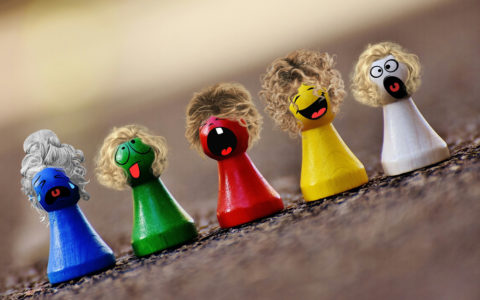Mental Illness in Children: Signs and Symptoms for Treatment
Christian Counselor Spokane
Parenting, we all know, can be rough, and unfortunately our children do not come with manuals on how to raise a successful child in three steps. (Boy would that be great!) But since we do not have this magic wand book and all-knowing wisdom, raising a child can be an amazing adventure of trial and error and many times living in the land of “not knowing.”
To make our adventure a little more challenging, some parents may find that their child is exhibiting signs of mental illness.
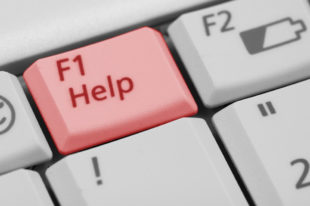 In this article I hope to give us working definitions of mental illness, signs and symptoms to look for, how to parent challenging behaviors, and when to seek treatment from a professional.
In this article I hope to give us working definitions of mental illness, signs and symptoms to look for, how to parent challenging behaviors, and when to seek treatment from a professional.Mental health in childhood is characterized by the achievement of developmental and emotional milestones, healthy social development, and effective coping skills, such that mentally healthy children have a positive quality of life and can function well at home, school, and in their communities.
Mental disorders are described as “serious deviations from expected cognitive, social, and emotional development” and include conditions meeting criteria described by the Diagnostic and Statistical Manual of Mental Disorder, 5th edition (DSM 5), or the International Classification of Diseases (ICD 10).
Mental Illness in Children: Statistics
Recently the terms mental, emotional, or behavioral disorders have been used to refer to diagnosed mental or substance use disorders.
Let me give you some statistics before we begin:
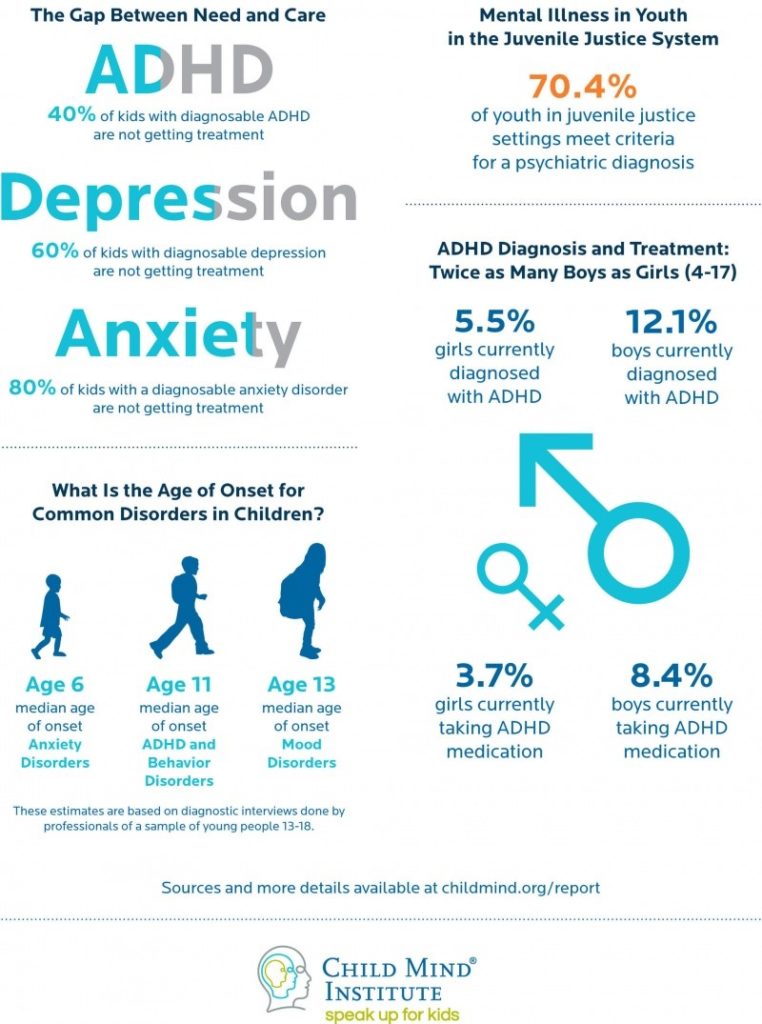
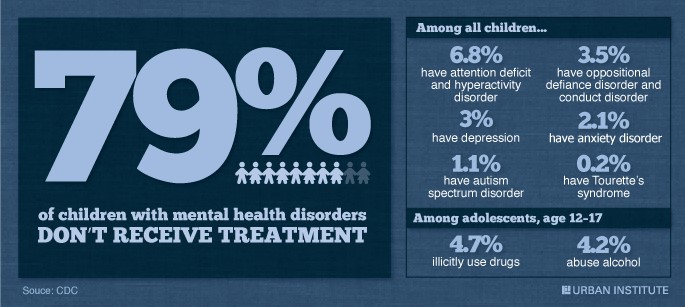
Children aged 3-17, 2005-2011
- ADHD: 6.8%
- Anxiety: 3%
- Depression: 2.1%
- Behavioral or conduct problems: 3.5%
- Autism spectrum disorders: 1.1%
- Tourette Syndrome: .2% (among children aged 6-17years)
- Behavioral or conduct problems: 3.5%
- Illicit drug use disorder: 4.7%
- Alcohol use disorder: 4.2%
- Cigarette dependence in the past month: 2.8%
- Suicide was the second leading cause of death among adolescents aged 12-17 years in 2010.
- It has been noted by the National Research Council and Institute of Medicine that 13-20% of children living in the United States experience a mental disorder in each year and money spent towards these disorders is estimated at $247 billion each year.
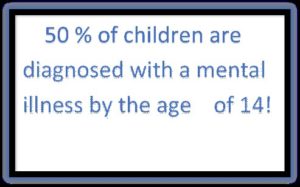
The statistics are astounding, giving us as providers and parents an alert to pay close attention to our children. Now we will look at what the most common diagnoses are in children.
Childhood Disorders are often labeled as developmental disorders or learning disorders.
Most commonly diagnosed symptoms in children:
- Anxiety Disorders (GAD, Separation Anxiety, Social Anxiety)
- Attention Deficit/Hyperactivity Disorder (AD, HD)
- Disruptive Behavior Disorders: Oppositional Disorder, Conduct Disorder
- Pervasive Development Disorders
- Eating Disorders
- Elimination Disorder (Encopresis, Enuresis)
- Affective (Mood Disorders), Including Depression, Bipolar Disorder, Disruptive Mood Dysregulation Disorder)
- Schizophrenia
- Tic Disorders
- Tourette Syndrome
- Substance Abuse
- Autism Spectrum Disorder (Formerly Asperger’s, Autistic Disorder, & Rett’s)
- Attachment Disorder
- Attention-Deficit/Hyperactive Disorder
- Autism
- Conduct Disorder
- Disorder of Written Expression
- Disruptive Mood Dysregulation Disorder
- Encopresis
- Enuresis
- Expressive Language Disorder
- Mathematics Disorder
- Intellectual Disability
These disorders are all classified in the DSM-5 used by clinicians and medical professionals in the diagnosis and treatment of these disorders.
Common Symptoms of Mental Illness in Children
Many parents will ask me as a clinician, “What are the signs to look for, and how do I know if this is just a phase or developmental normality?”
Here are some of the common symptoms which one can look for in their child.
- Changes in school performance
- Abuse of drugs or alcohol
- Inability to cope with daily problems and activities
- Changes in sleeping and/or eating habits
- Excessive complaints of physical ailments
- Defying authority, skipping school, stealing or damaging property
- Intense fear of gaining weight
- Long-lasting negative moods, often accompanied by poor appetite and thoughts of death
- Frequent outbursts of anger
- Loss of interest in friends and activities they usually enjoy
- Hitting and bullying other children
- Lying
- Extreme sweating in social situations or change of activity
- Lack of concentration
- Upset frequently with intense crying
- Inappropriate affect (laugh excessively, cry, etc.)
- Significant increase in time spent alone
- Excessive worry or anxiety
- Persistent nightmares or night terrors
- Persistent disobedience or aggressive behavior
- Frequent temper tantrums
- Hearing voices or seeing things that are not there (consider cultural context)
- Odd body movements
- Distorted thinking
- Abnormal mood swings
- Acting overly suspicious of others
- Not concerned with her or his appearance
- Attempting to injure him or her self
- Lacking energy or motivation
- Talking faster or louder than everyone else and then get mad if someone interrupts him/her.
- Feel like they have special powers (e.g. flying if they jump from roof)
- Racing thoughts
- Obsessive thoughts concerning body parts
If your child begins to exhibit these symptoms, especially over two weeks or more, it probably is best to seek out professional help.
Treatment Options for Mental Illness in Children
Psychotherapy
Before therapy, the parent would be best served to watch the child closely and write down situations, triggers, and behavior.
Types of psychotherapy include supportive, cognitive behavioral, interpersonal, group, and family therapy
Creative Therapies
Types include art therapy, play therapy, and animal-assisted therapy (this is found to be helpful with children who have trouble communicating their feelings and thoughts)
Medication
The major type of antidepressants and anti-anxiety medication prescribed for children is the selective reuptake inhibitors (SSRIs). These are prescribed more by doctors due to the high level of effectiveness and general safety for use in children.
These include:
- Fluoxetine (Prozac)
- Sertraline (Zoloft)
- Citalopram (Celexa)
- Escitalopram ( Lexapro)
- ADHD medications
It is noteworthy to discuss that if a child is diagnosed with ODD, its name is a misnomer because it is not so much a disorder as it is a learned behavior and/or due to environmental factors and inherited factors, such as parents who are ineffective, inconsistent, and/or use harsh discipline; lack of supervision; neglect or abuse; and limitations or developmental delays in a child’s ability to process their thoughts and feelings.
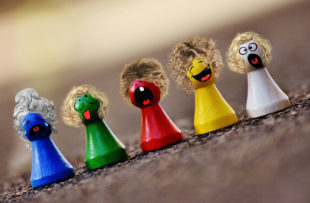 There is no medication to “fix” ODD, but with a fixed and consistent routine, a child can unlearn these behaviors. However, we do know that children who have ODD also have a comorbidity of ADHD, anxiety, and depression, which can be helped with psychotropic medications but are more so by psychotherapy for both the child and parents.
There is no medication to “fix” ODD, but with a fixed and consistent routine, a child can unlearn these behaviors. However, we do know that children who have ODD also have a comorbidity of ADHD, anxiety, and depression, which can be helped with psychotropic medications but are more so by psychotherapy for both the child and parents.
How to Deal with Aggressive Behavior in Children
One type of behavior which can be overwhelming for both parent and child is when a child exhibits aggressive behavior towards themselves, the parents, or peers.
Here are some suggestions for dealing with aggressive kids.
Questions to ask yourselves as parents:
- What kinds of situations usually lead to your child acting aggressively? Why do you think this is?
- When your child acts in ways that seem aggressive, how do you typically react? Do you think this reaction is helpful to your child or not? Why?
Step 1: Observe and learn
- What is going on in your child’s world?
- Where is the behavior happening? Home? Childcare? Shopping Mall? Grandma’s? Or is it happening in all/most of the settings your child is in?
- If it is only happening in one setting, could there be something about that environment (crowded, bright, overwhelming) that is triggering the behavior?
- Is the behavior directed toward one specific person or a small group of people?
- When does the behavior usually happen? For example, right before nap, when your child is tired? Transitions?
- What happened right before your child’s challenging behavior? Did you just announce it was time to stop playing and get in the car? Had another child taken a toy from him?
- Has there been a recent change in her world that is making your child feeling upset, out of control, sad, or perhaps less safe and secure? Events like switching rooms at child care, moving homes, a new baby, or the loss of a pet can make your child feel insecure and therefore less able to control her impulses.
Other important factors to remember
- Developmental Stage: Is the behavior typical for your child’s age/stage? For example, some hitting and biting is normal for toddlers, but multiple times during the week would be more of a concern.
- Child’s temperament*: Could the behavior be explained, in part, by the child’s way of approaching the world? For example, a very intense sensitive child may feel overwhelmed in settings when there is a lot of stimulation, such as free playtime. He may bite to cope – perhaps to keep people at a distance to protect himself. A child that is slow to warm up may hit a parent when left with a new babysitter. Fear often gets expressed as anger in young children (not to mention many adults).
- Your Own Temperament and Life Experiences*: Is this behavior particularly difficult for you? If so, why? Sometimes a parent’s own past experience – for example, having had parents with very strict rules about how to behave at a restaurant – influences her reactions to her child’s behavior. She then may have a short fuse when dealing with her own squirmy child at the diner. Being aware of these kinds of connections helps you look at and respond to your child’s behavior more effectively, and in ways that are based on her age, stage of development, and temperament.
- * What’s Going on With You?
- Ask: How do you handle your own feelings when your child acts aggressively? Are you able to calm yourself before you respond?
* Think prevention: Use what you know about your child to plan.
Heading Off Aggression
- Give advanced notice of an upcoming change. “We will read one more book and then it’s time to get in the car to go home. Which book do you want to read? (Giving choices can help children feel more in control and reduce aggression.)
- Help your child understand her feelings and behavior. This self-awareness helps him to learn to manage his feelings in positive ways.
Strategies for Responding to Aggression
- Stay calm. This is the essential first step.
- Recognize your child’s feeling or goal. Let your child know that you understand what he wants to do.
- Use words and gestures to communicate your message. Words alone may not be enough to get your toddler to stop an unacceptable activity.
- Offer alternatives. Tell and show your child acceptable ways to reach his goal or channel his energy.
- Try a distraction. If your child is highly agitated, try a distraction. This is an unpredictable response your child isn’t expecting.
- Remind your child that she can always come to you for help.
- Be consistent. Consistency with rules is key to helping children learn to make good choices.
- Avoid negotiation. Negotiating about family rules is a slippery slope.
- Give your child a chance to problem solve before stepping in. If he comes to you, you can help him by offering suggestions.
- Give your child lots of positive feedback when she shows self-control. It is healthy to help children experience and understand the natural benefits of good behavior.
- Identify and reduce stressors.
- Identify a person and place where the child can go if symptoms are overwhelming.
- Make a Daily Life Chart. Keep a chart of your child’s mood, behaviors, and sleep patterns. It can help the parent and the child understand and track the illness. A chart can also help the doctor see whether treatment is working.
When to Seek Help
- Some aggressive behavior is a typical part of early childhood development. However, if a child’s aggression is interfering with his ability to interact with others in positive ways, his ability to explore and learn, or if you find that because of your child’s aggressive behaviors you avoid having him play with other children or taking him to other activities, it can be very helpful to seek guidance from a child development professional or mental health counselor.
- When a child appears reckless, taking a “daredevil” approach to life. This approach often leads to breaking things or intrusive behavior (getting into another people’s space).
- Seems to crave high-intensity sensory stimuli. Sometimes children who need lots of “touch” to feel centered get this sensory input in unacceptable ways (hitting, shoving, pushing, etc.).
- Engages in unprovoked hitting; acts aggressively “out of the blue” or for no reason you can see.
- Shows a preoccupation with aggressive themes in pretend play.
- Begins acting aggressively following a traumatic episode or major life change.
Aggressive behaviors are some of the more serious symptoms which parents must deal with. If these behaviors are present in your child, please do not hesitate to call a professional and start the first steps to healing. The earlier one can detect these issues and seek help, the better the prognosis and the road to recovery for you and your little one.
Photos
“Help button,” courtesy of PublicDomainPictures.com, pixabay.com, CC0 License; “Emotions,” courtesy of Alexas_Fotos, pixabay.com, CC0 License

